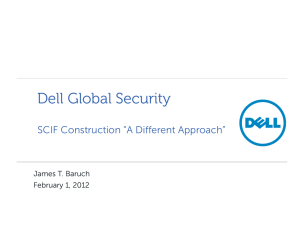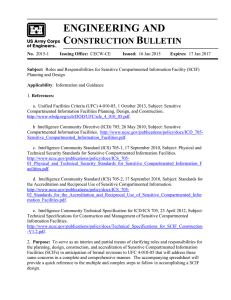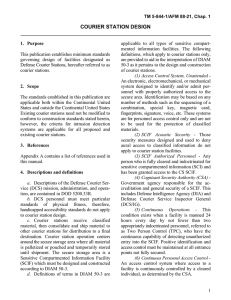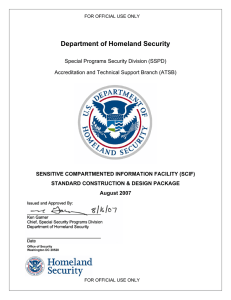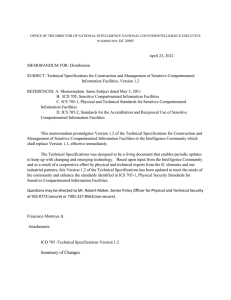E C B
advertisement
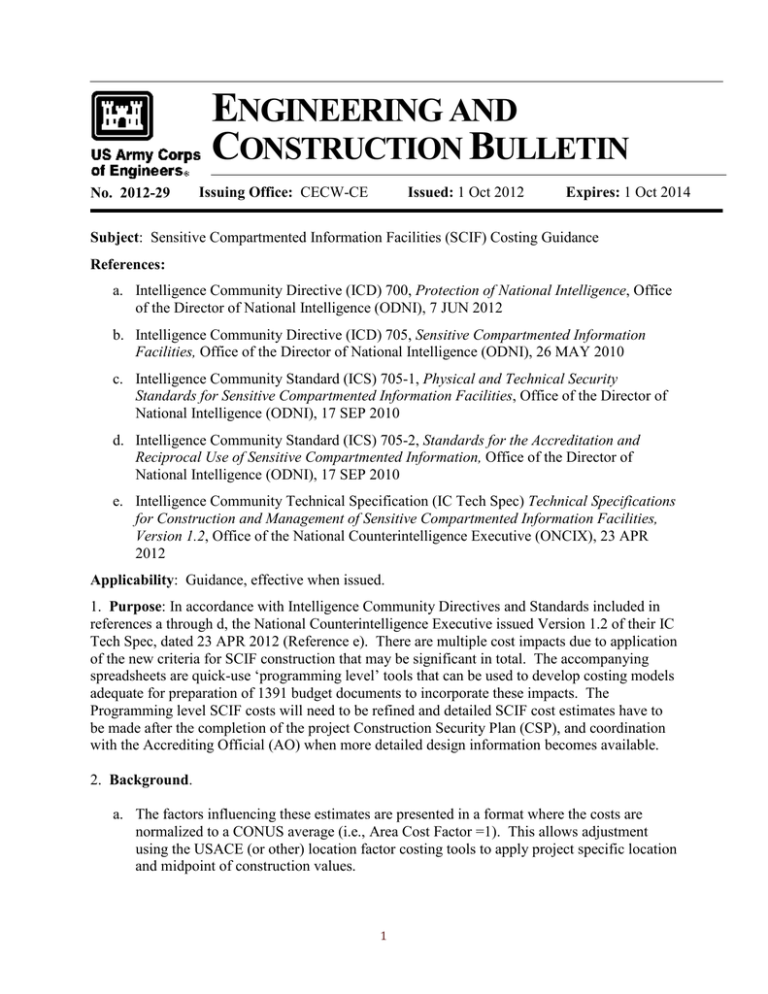
ENGINEERING AND CONSTRUCTION BULLETIN No. 2012-29 Issuing Office: CECW-CE Issued: 1 Oct 2012 Expires: 1 Oct 2014 Subject: Sensitive Compartmented Information Facilities (SCIF) Costing Guidance References: a. Intelligence Community Directive (ICD) 700, Protection of National Intelligence, Office of the Director of National Intelligence (ODNI), 7 JUN 2012 b. Intelligence Community Directive (ICD) 705, Sensitive Compartmented Information Facilities, Office of the Director of National Intelligence (ODNI), 26 MAY 2010 c. Intelligence Community Standard (ICS) 705-1, Physical and Technical Security Standards for Sensitive Compartmented Information Facilities, Office of the Director of National Intelligence (ODNI), 17 SEP 2010 d. Intelligence Community Standard (ICS) 705-2, Standards for the Accreditation and Reciprocal Use of Sensitive Compartmented Information, Office of the Director of National Intelligence (ODNI), 17 SEP 2010 e. Intelligence Community Technical Specification (IC Tech Spec) Technical Specifications for Construction and Management of Sensitive Compartmented Information Facilities, Version 1.2, Office of the National Counterintelligence Executive (ONCIX), 23 APR 2012 Applicability: Guidance, effective when issued. 1. Purpose: In accordance with Intelligence Community Directives and Standards included in references a through d, the National Counterintelligence Executive issued Version 1.2 of their IC Tech Spec, dated 23 APR 2012 (Reference e). There are multiple cost impacts due to application of the new criteria for SCIF construction that may be significant in total. The accompanying spreadsheets are quick-use ‘programming level’ tools that can be used to develop costing models adequate for preparation of 1391 budget documents to incorporate these impacts. The Programming level SCIF costs will need to be refined and detailed SCIF cost estimates have to be made after the completion of the project Construction Security Plan (CSP), and coordination with the Accrediting Official (AO) when more detailed design information becomes available. 2. Background. a. The factors influencing these estimates are presented in a format where the costs are normalized to a CONUS average (i.e., Area Cost Factor =1). This allows adjustment using the USACE (or other) location factor costing tools to apply project specific location and midpoint of construction values. 1 ECB No. 2012-29 Subject: Sensitive Compartmented Information Facilities (SCIF) Costing Guidance b. A multiplier (or several multipliers) can ‘scale up’, based on changes in the SCIF size, Risk and TEMPEST rating factors, location, and other factors. c. A programming level cost model is conceptual, compared to the level of details found in the final Cost Estimate, referred to as the Current Working Estimate (CWE). It is assumed that a project containing SCIF spaces would have a user/owner that would be familiar with the new SCIF criteria. Specific technical references, assemblies, material choices, specifications, and details are covered in depth in the ODNI 705 / IC Tech Specs documents, and are not repeated in this conceptual costing model. d. Costs will vary, and are dependent on the following: (1) Size of the facility. (2) Risk Rating of the facility. (3) TEMPEST Rating of the facility (if needed). (4) Location of Construction (inside US, outside of US (simple), or outside of US (complex). (5) Costs outside of US will also need to capture possible TDY costs of CSP team members. 3. Guidance. Please see the attached SCIF Costing Model spreadsheets. There are three worksheets: a blank template which will work for both CONUS and OCONUS projects, a sample CONUS cost worksheet and a sample OCONUS cost worksheet. a. User-input blocks are located in columns e, h, and i. These blocks require some limited project information and input from the project programmer. These blocks are surrounded by dashed lines. These are the only values that should be modified by the users. b. For each of the five steps listed at the left, select the most appropriate answer for each step, and indicate the choice with an ‘x’ in the box in column e. c. Record the associated Factor values for the Attributes selected into the boxes to the right in columns h and i. The user will need to carry over a Factor value for both construction and security labor costs from columns f and g into columns h and i. Some Factor values may be zero. d. If working electronically, the spreadsheet will add the Factor values in each column and display the total value at the ‘sum’ line. If working the spreadsheet by hand (on paper), the values must be tabulated by hand. e. The user must next input the appropriate Baseline Unit cost. The Baseline Unit Cost value represents location and size adjusted per Square Foot cost for a General Purpose 2 ECB No. 2012-29 Subject: Sensitive Compartmented Information Facilities (SCIF) Costing Guidance Administrative Facility (catcode 610-50) escalated to the mid-point-of construction of the SCIF project. f. The next row, titled as “Area Adjusted per Square Foot SCIF Costs” will be automatically calculated, if working electronically, for each column - Construction and Security Administration. g. The final result of this worksheet will be added per square foot costs titled “Enhanced SCIF Construction Cost” and “Security Administration Cost.” Enhanced SCIF Construction Cost will be recorded as a subline under the Primary Facility Cost line in Tab-A of the Form DD1391. The second value, titled “Security Administration Costs” is a new cost line to DD1391, and should be reported below the Supervision, Inspection and Overhead Cost line in Tab-A of DD1391, as this will likely be a separated cost or services type contract, similar to a subcontractor commissioning or LEED subcontract. 4. Contact. Questions on the use of these tools, and suggestions for enhancements, should be directed to Daniel G. Kurmel; USACE Protective Design Center, Omaha District, phone number 402-995-2369 or email daniel.g.kurmel@usace.army.mil. The Headquarters USACE point of contact for this ECB and its distribution is Eric Mucklow at eric.mucklow@usace.army.mil. //S// JAMES C. DALTON, P.E., SES Chief, Engineering and Construction Division Directorate of Civil Works //S// LLOYD C. CALDWELL, P.E., SES Chief, Programs Management Division Directorate of Military Programs Encl. 3

